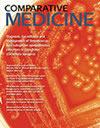Identification and Control of an Ornithonyssus bacoti Infestation in a Rodent Vivarium by Using Molecular Diagnostic Techniques.
IF 1.1
4区 农林科学
Q2 VETERINARY SCIENCES
引用次数: 1
Abstract
Ornithonyssus bacoti, commonly known as the tropical rat mite, is a zoonotic ectoparasite that occasionally infests research rodent colonies. Most infestations have been attributed to wild rodents that harbor the mite and spread it to research animals, often during building construction or other activity that disrupts wild rodent populations. Although infestation may be clinically silent, severe outbreaks have been reported to cause pruritis, dermatitis, decreased reproductive performance, and anemia in rodents. In mid 2020, our institution experienced increased activity of wild mice, which were found to be infested with O. bacoti, diagnosed by microscopic exam and confirmed by fur swab PCR analysis. We elected to add O. bacoti to our quarterly health monitoring exhaust air dust (EAD) testing PCR panel, increase wild mouse control measures, and treat the environment with a sustained-release synthetic pyrethroid spray in an attempt to prevent colony animal infestation. Initial quarterly EAD health monitoring results in September of 2020 were negative for O. bacoti. However, in early 2021, multiple IVC racks tested positive for O. bacoti at quarterly testing. Treatment consisted of providing permethrin soaked nesting material and surface spray treatment of the room and hallway with a sustained-release synthetic pyrethroid. Historically in the literature, O. bacoti outbreaks of research mice were not identified until mite burden was high enough to cause dermatitis on animal care workers. Due to modern molecular diagnostics and proactive PCR-based health monitoring surveillance, we were able to identify the outbreak earlier than would have otherwise been possible. To the best of our knowledge, this is the first report to successfully identify O. bacoti using environmental health monitoring PCR techniques. This outbreak demonstrates the importance of screening for O. bacoti in facilities with the potential for wild rodent infestation and highlights unique considerations when managing O. bacoti infestations. In addition, a novel permethrin-soaked enrichment item was developed for cage-level treatment.利用分子诊断技术鉴定和防治鼠类体内一种烟熏鸟虱。
弓形虫,俗称热带鼠螨,是一种人畜共患的体外寄生虫,偶尔会感染研究中的啮齿动物群落。大多数感染归因于野生啮齿动物携带螨虫并将其传播给研究动物,通常是在建筑施工或其他破坏野生啮齿动物种群的活动期间。虽然感染在临床上可能无症状,但据报道,严重的暴发会导致啮齿动物出现瘙痒、皮炎、生殖能力下降和贫血。2020年年中,本机构野生小鼠活动增加,经显微镜检查诊断,毛拭子PCR分析证实,发现野生小鼠感染了O. bacoti。我们选择将O. bacoti添加到我们的季度健康监测排气粉尘(EAD)检测PCR面板中,增加野生小鼠控制措施,并使用合成拟除虫菊酯缓释喷雾剂处理环境,以防止群体动物侵害。2020年9月初步季度EAD健康监测结果为阴性。然而,在2021年初,多个IVC货架在季度检测中检测出O. bacoti阳性。处理方法包括提供氯菊酯浸泡的筑巢材料,并用缓释合成拟除虫菊酯对房间和走廊进行表面喷雾处理。在历史文献中,直到螨虫负担高到足以引起动物护理工作者的皮炎时,才发现研究小鼠的杆菌病暴发。由于现代分子诊断和基于聚合酶链反应的主动健康监测,我们能够比其他方法更早地发现疫情。据我们所知,这是第一份利用环境健康监测PCR技术成功鉴定出O. bacoti的报告。这次暴发表明了在可能发生野生啮齿动物侵扰的设施中筛查烟性无毛杆菌的重要性,并强调了在管理烟性无毛杆菌侵扰时需要考虑的特殊事项。此外,还开发了一种新型氯菊酯浸泡富集物,用于笼级处理。
本文章由计算机程序翻译,如有差异,请以英文原文为准。
求助全文
约1分钟内获得全文
求助全文
来源期刊

Comparative medicine
医学-动物学
CiteScore
1.90
自引率
0.00%
发文量
71
审稿时长
6-12 weeks
期刊介绍:
Comparative Medicine (CM), an international journal of comparative and experimental medicine, is the leading English-language publication in the field and is ranked by the Science Citation Index in the upper third of all scientific journals. The mission of CM is to disseminate high-quality, peer-reviewed information that expands biomedical knowledge and promotes human and animal health through the study of laboratory animal disease, animal models of disease, and basic biologic mechanisms related to disease in people and animals.
 求助内容:
求助内容: 应助结果提醒方式:
应助结果提醒方式:


